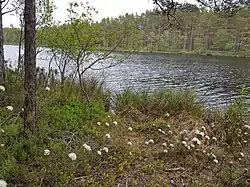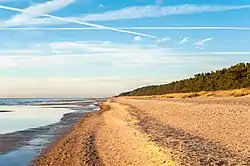Piejūra
Dabas parks Piejūra (lit. 'Nature Park Piejūra') is a nature park along the Gulf of Riga in Latvia founded in 1962. It is a protected nature reserve and a Natura 2000 location. The park stretches 36.6 kilometres (22.7 mi) over an 4,180 hectares (10,300 acres) area from Riga, through Carnikava Municipality, and up to Saulkrasti. It is a popular seasonal recreation location, notably for beach access. The park is notable for its protected biotopes, particularly its dunes and boreal forests. The park's conservation plan for 2020 onwards was developed under the "LIFE CoHaBit" project.
| Piejūra | |
|---|---|
 Bank of Garezers lake | |

| |
| Type | Nature park |
| Location | Riga, Carnikava Municipality, and Saulkrasti Municipality, Latvia |
| Coordinates | 57°7′15″N 24°13′52″E |
| Area | 4,180 hectares (10,300 acres) |
| Created | 1964 |
| Operated by | Pierīgas reģionālā administrācija |
| Designation | Nature reserve, Natura 2000 |
Location
The nature park is a protected area designated as a nature reserve in Latvia , as well as a Natura 2000 territory.[1] It is the third oldest nature park in Latvia.[2] The park was formed primarily for the preservation of biotopes. A concrete goal is to further the coexistence of oligotrophic to mesotrophic plants in mineral-starved mesotrophic lakes and their coasts.[1]
The area of the park is 4,180 hectares (10,300 acres).[1][3] The territory is located in Rīgavas līdzenums (Rigava plain) in lv:Piejūras zemiene (Seaside lowland) coastal zone. The park stretches 36.6 kilometres (22.7 mi) along the coast of the Gulf of Riga, with up to 2.8 kilometres (1.7 mi) wide areas and occupies 7% of coastal zone in Latvia.[3] The territory spans from Vakarbuļļi village North-West of Riga, through Carnikava Municipality, and up to Inčupe river South-West of Saulkrasti [1][4][3] The park borders the Lielupe and Daugava river estuaries and includes 1.6 kilometres (0.99 mi) of Gauja estuary.[3]
The park is primarily owned by State (56%), municipalities (40%) and only 4% privately.[5] There are few permanent residents in the area and most infrastructure is outside the area.[3] The park is divided into 3 functional zones: nature reserve, nature park and neutral zones.[5]
Geology
The 40–50 metres (130–160 ft) to 80–100 metres (260–330 ft) thick terrain consists of sand, aleurites and clay deposits, primarily from Baltic Ice Lake, Littorina Sea and its lagoons as well as alluvial river and delta sediments. Most of the territory is covered with around 2 metres (6 ft 7 in) meter thick sand sediment with up to 10–25 metres (33–82 ft) in dune ridges. The majority of territory's height ranges between 3–7 metres (9.8–23.0 ft) with up to 20–28 metres (66–92 ft) in the dune ridges. The newer West side is only 0.5–1.5 metres (1 ft 8 in–4 ft 11 in) high.[3]
There are 7 natural lakes in the park – Ummis, Dienvidu Garezers, Vidējais Garezers, Ziemeļu Garezers, Dziļcaurums, Serģis, and Mazlandziņa. The first of the 6 formed 4000-6000 years ago from the receding sea and are the only example of such formation in Latvia. All lakes are 2–3.7 metres (6 ft 7 in–12 ft 2 in) above sea level and are shallow ranging between 1–9 metres (3 ft 3 in–29 ft 6 in) in depth. There is only one notable bog – a mostly wet and swampy Serģu purvs – with a depression area of 556 hectares (1,370 acres) which formed as Serģa lake was drained via ditches dug in 1906. Most of its territory is of transition mire and quaking bog (7140) biotope.[3]
Ecology
80% of the park's area are forests, 10% are beaches and dunes, while only 2% are human infrastructure. The park contains 24 identified EU biotopes that make up 84% of the territory. The most common biotopes are forested coastal dunes (2180), fixed coastal dunes with herbaceous vegetation (2130) and old boreal forests (9010).[3] Biotopes of particular conservation interest are embryonic shifting dunes (2110), foredunes (2120), forested coastal dunes and old boreal forests,[1] Northern boreal alluvial meadows (6450), boreal Baltic coastal meadows (1630).[4]
Many rare plant and animal species are found here.[1] Plant species are mainly determined based on the park's sand bedrock, high groundwater levels and poor natural drainage. Many rare vascular plant species are found here.[3] The park is one of the most notable bird migration routes in Europe. Various water birds and songbirds can be found here, including sightings of Eurasian eagle-owls and Sea eagles.[2]
Climate
The climate in the park is moderately warm and wet. There are lesser temperature fluctuations compared to the inland. The sea water accumulates warmth during summer and makes the autumn and winter warmer than inland. However, this also makes spring and summer cooler due to slower water warming. There are stronger winds in the park than inland, with coastal and sea breezes from interaction between water and land. The vegetation period is about 200 days, while the snow cover can remain up to 100 days a year.[3]
History
_burying_the_forest_in_Carnikava_municipality.jpg.webp)
The main terrain of the park formed during the 5–7 thousand years during and after the Littorina Sea period. The new Western area only formed 300–400 years due to construction of dams and piers around Daugava delta.[3]
Between 19th and 20th century, the area between Lielupe estuary and Pabaži used to have a 2,200 hectares (5,400 acres) area with sand and dune fields, either naked or with shallow scrub overgrowth.[6] Due to long-term effects of wind, this sand become shifting dune ridges that slowly "travelled" over 200 years, burying old forests, waterways and damaging infrastructure.[6][7][8] In 1870s, about 200 hectares (490 acres) area was buried around Riga between Daugava and Lielupe estuaries. The lack of drainage caused the meadows to become swampy and required expensive canal construction for water drainage.[6] In 1930s, Piejura area had about 1,000 hectares (2,500 acres) of unsecured flowing sand with some ridges like Bākas hill moving and burying forest 1.85 metres (6 ft 1 in) per year. To stop the shifting sands, forestation works were carried out first covering the sand with branches and planting scrub and bushes to stop the sand movement and later planting trees to secure the area long-term.[7] Towards the end of 20th century, the sand movement had stopped.[8]
The park itself was officially founded as a nature park in 1962.[1][2] Latvian SSR Council of Ministers made the decision to create the park along the over 1,500 hectares (3,700 acres) territory between Vecāķi and Carnikava, between the coast and railroad, although, no immediate work took place in the following years.[9] The nature park was established to protect the forested coastal dune and foredune biotopes, as well as the beach. The territory originally covered 1,629 hectares (4,030 acres) from Vecāķi neighbourhood to Gauja river estuary. Various border adjustments were made since then. Notably, in 1999 the park was expanded to its current area by including areas to be conserved from Vakarbuļļi to Inčupe. In 2002, the park was added to Natura 2000 as type C for preservation of especially protected species and biotopes. In 2004, the "LIFE Piekraste" project established the park's maintenance guidelines until 2015, later extended to 2019.[3] Since 2006, the protection and usage of the park are codified in law.[10] Between 1 September 2016 and 31 August 2020, the "LIFE CoHaBit" project surveyed and analysed the territory and formed a plan for protection, management and development of the park for 2020 onwards.[3][5][11] The project cost €970 thousand, of which €582 thousand was financed by the EU.[11]
Tourism

The park is a popular tourism recreational location.[2] Most anthropogenic effects on the park are from its visitors. Although the park is regularly visited by nearby residents, larger visitation from Riga and near-Riga is irregular and seasonal. Summer season attracts most visitors, especially for beach visits. Weekend visitation is much higher than during work days. Recreational activity is also very different between park locations. For example, beach visitation is concentrated in locations with easier access and near-beach infrastructure. According to a survey of park visitors, most arrive by foot (37%), car (36%) or bike (14%). The primary purposes are for swimming, sunbathing, hiking and other recreation.[3]
Over the years, the park has had problems with people littering and dumping garbage, including "green trash" and composts that propagate invasive species.[12] People also commonly swim in the Ummis lake, one of Latvia's cleanest lake where swimming if forbidden during summer, while information signs are commonly vandalized.[13][14] Motorized vehicles are often illegally parked in the park,[15] and the lack of car and pedestrian access, as well as designated parking space damages the park.[14]
Protection plan
The 2004 plan was replaced with the plan formed as part of the project "LIFE CoHaBit – Piekrastes biotopu aizsardzība dabas parkā "Piejūra"" (transl. Coastal biotope protection in nature park Piejura). The project was funded by EU's The LIFE Programme and The State Regional Development Agency. The new territory protection plan was developed by Ministry of Environmental Protection and Regional Development. The plan is set to last until 2031.[5]
One of the primary goals of the plan is reduction of anthropogenic impact.[16][14] The plan raises special attention to protection of plant species and reduction of lake eutrophication. It also calls attention to development of tourism infrastructure and availability of information, as well as reduction of dune damage due to visitors.[5][16] The plan also asks to further divide the park into functional zones: regulated regime, nature reserve, nature park and neutral zones.[5]

References
- "Piejūra" (in Latvian). Administration of Latvian Environmental Protection Fund. 24 October 2020.
- "Piejūras dabas parks" [Nature Park Piejura] (in Latvian). Rīgas Meži.
- "Dabas parka "Piejūra" dabas aizsardzības plāns" [Nature Protection Plan for Nature Park Piejura] (PDF) (in Latvian). Riga City Council City Development Departament.
- "Teritorija" [Territory] (in Latvian). Dabas aizsardzības pārvalde. 21 February 2017.
- "Apstiprināts dabas parka "Piejūra" dabas aizsardzības plāns (2020.–2031.)" [Nature Protection Plan for Nature Park Piejura (2020–2031) Has Been Approved] (in Latvian). Riga City Council City Development Departament.
- "Plūstošās piejūŗas smiltis" [Flowing coastal sands]. Nedēļa (in Latvian) (27). July 1925.
- "Plūstošo smilšu nostiprināšana un apmežošana Rigas virsmežniecībā" [Consolidation and Afforestation of Flowing Sand in Riga Surface Forestry]. Meža Dzīve (in Latvian) (3). November 1925.
- B. Lielmeža (July 1989). "Piejūras dabas parkā" [In Piejura Nature Park]. Darba Balss (in Latvian). Rīgas rajons (87).
- I. Riekstiņš (February 1969). "Būt vai nebūt piejūras dabas parkam?" [In Piejura Nature Park]. Literatūra un Māksla (in Latvian) (7).
- "Dabas parka "Piejūra" individuālie aizsardzības un izmantošanas noteikumi" [Individual Protection and Usage Regulation for Nature Park Piejura]. Act of 14 March 2006 (in Latvian). Riga.
- "Par projektu" [About the Project] (in Latvian). Dabas aizsardzības pārvalde. 27 February 2017.
- Zemgales reģionālā televīzija (23 June 2020). "Cīnās ar dabas parka "Piejūra" piesārņotājiem" [Fighting the Litterers of Nature Park Piejura] (in Latvian). Public Broadcasting of Latvia.
- Madara Līcīte (12 August 2020). "Atpūtnieki ignorē aizliegumu peldēties Ummja ezerā" [Vacationers Ignore Ban on Swimming in Lake Ummis] (in Latvian). Public Broadcasting of Latvia.
- Ieva Štāle (7 August 2018). "Saglabāt dabas un rekreācijas intereses" [To Preserve Nature and Recreation Interests] (in Latvian). Diena.
- Skaties.lv, Rīgas pašvaldības policija (3 June 2016). "Neaizmirsti! Auto novietošana dabas parka teritorijā var beigties ar 140 eiro sodu!" [Don't Forget! Leaving a Car in the Nature Park Territory Can Leave You With a 140 Euro Fine] (in Latvian). Skaties.CS1 maint: uses authors parameter (link)
- "Mērķi un uzdevumi" [Goals and objectives] (in Latvian). Dabas aizsardzības pārvalde. 21 February 2017.